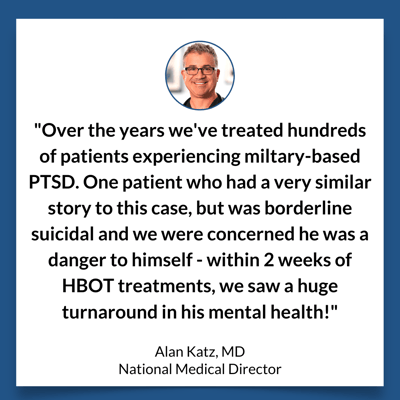For decades, avascular necrosis (AVN) of the femoral head was regarded as a degenerative...
Case Study: HBOT Helps a Vietnam Veteran with PTSD

CASE STUDY:
Patient Age: 75
Gender: Male
Presentation: Patient presented with a long-standing history of PTSD symptoms, including intrusive thoughts, nightmares, panic attacks, anxiety, depression, hyper-vigilance and irritability.
Health History: Blast induced PTSD. Patient receives medical care at his local VA hospital, and was attending regular counseling sessions as well as group therapy.
Personalized Treatment Protocol: Hyperbaric Oxygen Therapy 5 days a week for a total of 40 sessions. Session length of 60 minutes at 1.5 ATA.
Patient Outcome:
Patient was reassessed using the CAPS and PCL-5. The post-treatment scores demonstrated a significant reduction in overall symptom severity compared to baseline.
The patient reported a decrease in intrusive thoughts, nightmares, hypervigilance, and irritability. Additionally, improvements were noted in his mood, sleep quality, and overall functioning. He also reported a greater sense of calmness, improved ability to manage stress, and enhanced social interactions.
Notes from the clinical team at HMS about HBOT for PTSD
Post-traumatic stress disorder (PTSD) is a debilitating psychiatric condition that can develop following exposure to traumatic events. Among veterans, PTSD is very prevalent. Standard treatment options for PTSD include psychotherapy, medication, and cognitive-behavioral interventions. However, not all individuals respond favorably to these approaches, necessitating the exploration of alternative therapies such as Hyperbaric Oxygen Therapy (HBOT).

HBOT involves the administration of 100% oxygen in a pressurized chamber, allowing the patient to breathe in oxygen at a higher pressure than atmospheric conditions. The increased pressure facilitates the dissolving of oxygen into the bloodstream, resulting in elevated tissue oxygen levels. This therapy has been primarily used for treating conditions like decompression sickness, non-healing wounds, and carbon monoxide poisoning.
HBOT and Neuroplasticity
Neuroplasticity refers to the brain's ability to reorganize and adapt its structure and function in response to experiences, learning, and changes in the environment. It involves the creation of new neural connections, strengthening existing ones, and even rewiring neural pathways. This process is essential for learning, memory formation, and recovery from brain injuries or diseases.
Hyperbaric oxygen therapy (HBOT) has been suggested to improve neuroplasticity by enhancing oxygen delivery to the brain, promoting neurogenesis, and reducing inflammation.
.png?width=400&height=400&name=Over%20the%20years%20weve%20treated%20hundreds%20of%20patients%20experiencing%20miltary-based%20PTSD.%20One%20patient%20who%20had%20a%20very%20similar%20story%20to%20this%20case%2c%20but%20was%20borderline%20suicidal%20and%20we%20were%20concerned%20he%20was%20a%20danger%20to%20himself%20-%20(1).png)
Conclusion
The positive outcomes observed in this case suggest that HBOT may hold promise as an effective treatment option for individuals with treatment-resistant PTSD, even for PTSD originating as far back as the Vietnam War. The potential mechanisms of action of HBOT, including increased tissue oxygenation, modulation of neuroinflammation, and promotion of neuroplasticity, may contribute to its therapeutic effects in PTSD.
More about the Author & Co-Author:
This case was presented and co-authored by Jodi Velocci, RPA-C, one of our lead physician assistants, who is overseen by Alan Katz, MD, our National Medical Director.
Written by Hyperbaric Medical Solutions
Hyperbaric Medical Solutions is a free-standing, independent medical practice, providing hyperbaric oxygen therapy (HBOT). HBOT is an advanced healing therapy that treats conditions that benefit from increased oxygen concentration and absorption in the body....
Read More
.png?width=640&height=257&name=Untitled%20(2240%20%C3%97%20900%20px).png)


